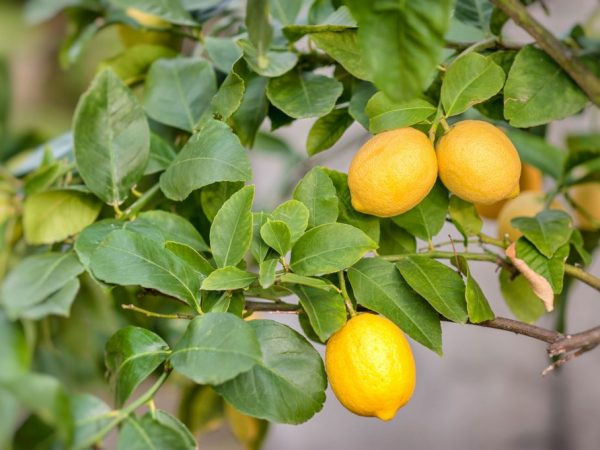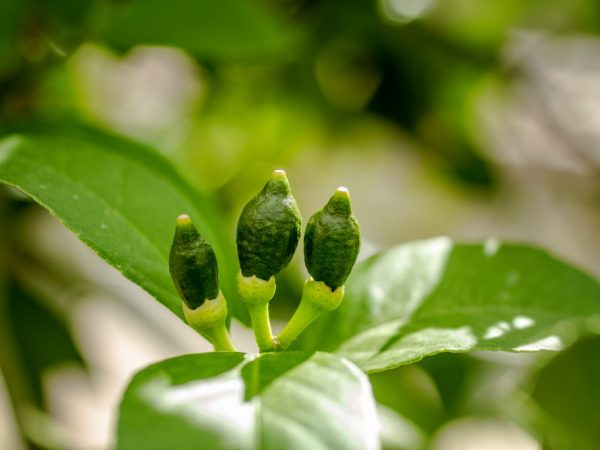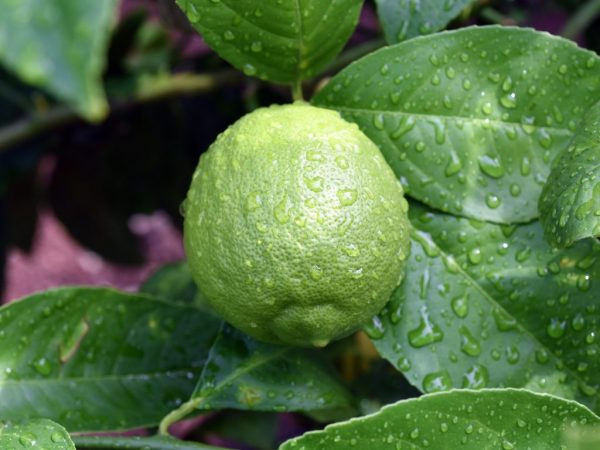Description of Meyer's lemon
Meyer's lemon is a perennial crop that belongs to the Citrus genus. The plant was brought from China and, after adaptation, is grown in any region. The variety is also suitable for planting at home.

Description of Meyer's lemon
Characteristics of the variety
Meyer's lemon is a hybrid variety - it withstands temperature changes and rarely gets sick, with the exception of viral diseases that can lead to the death of the crop.
Citrus bears fruit once a year. Fruiting occurs early. The tree has experienced several years of active growth, after which it begins to bloom and bear fruit. The optimal period for first fruiting is 5 or 6 years. The variety is early ripening, therefore, after flowering, no more than 8 months pass before the ripe fruit is obtained.
According to the characteristics of the Meyer lemon, it is suitable for home cultivation - it needs proper lighting and moisture, but otherwise the maintenance of the crop is minimal.
The disadvantages of the variety include the shape of the crown - the culture grows in the form of a bush, and not a tree, like other types of lemon varieties. To create the correct shape, pruning is carried out, especially in the first years of seedling growth. In winter, the tree completely or partially loses its foliage - this is a normal phenomenon due to slow processes in the rhizome. The variety differs in frost resistance: the tree can withstand air temperatures up to -10 ° C.
Description of the bush
In the open field, the tree grows up to 5 m, and at home, the maximum height of an adult bush is 2-3 m.
General characteristics of the bush:
- the shape of the crown is round and symmetrical;
- has many side branches that grow rapidly;
- has small thorns on old branches. They are located along the main trunk;
- leaves are small, dark green;
- leaves are tough.
At home, the bush grows quickly - it tends to grow in breadth, and not upward, therefore, special control is needed for the growth of side branches. The foliage on the bush is evergreen, it does not change its color, and in adverse conditions it simply falls off. According to the description, the inflorescences grow in the form of clusters, small in size and white or light purple in color. The smell of the inflorescences is pleasant, unobtrusive. The ovary is formed on young branches, and less on old inflorescences.
Description of fruits
The fruits of the variety are round and do not grow large. The average weight of one fruit is 100-120 g. The peel of the fruit changes from yellow to orange - the longer the fruit hangs, the darker it is. The surface of the fruit is smooth and shiny, there are no tubercles familiar to citrus. Citrus remains on the branches for a long period and does not lose its taste. The fruits cannot be transported for a long time, otherwise they will lose their presentation.
According to the characteristics of the Meyer lemon, the fruits of the variety have a specific taste - unlike other varieties, they taste more like oranges. The fruits are juicy. Lemon juice has a characteristic sourness.
Growing varieties
Landing requirements

Buy a grafted seedling for growing
Meyer's lemon can be purchased or planted by yourself. If it is a purchased copy, it must be grafted, i.e. go through the stock to give a good harvest. It is easier to grow a variety from a cuttings planted during the warmer months.
The propagation of Meyer's lemon is carried out from a perennial culture. The seedling must be grafted and soaked in a special solution (not less than 10 hours). If you plant a one-year-old cutting, the citrus will not take root or will grow weak. Young plants need transplanting - such activities will help improve the growth of the bush. In most cases, lemon propagation is carried out using seeds that are extracted from the fruit or by cuttings.
Landing in the soil
Meyer's lemon is planted in pots. Young seedlings are immersed in specially prepared soil. For such a mixture you will need:
- a piece of leafy land;
- part of the sand;
- part of humus (fertilizer);
- two parts of turf land.
This soil will provide the young shoots with all the nutrients they need for vigorous growth. For a lemon tree, a soil with neutral acidity is chosen. The root collar is immersed in the pot at the same level with the top layer of soil - this is an important condition for the rapid growth of the seedling. After planting, the seedling is watered abundantly. A young shoot is transplanted every year until the age of five - after that, the tree grows in a permanent pot, and only the upper layers of the soil change. During planting, drainage is established for the plant, which will not allow water to stagnate and the root system to rot.
Plant care
Caring for Meyer's lemon at home consists in constant watering, fertilizing the soil, pruning excess branches. Additionally, lighting is installed, without which the Meyer lemon does not grow. An important condition for the proper development of a lemon bush is air humidity. A humid climate is the most suitable environment for a seedling to grow.
It is impossible to put a pot near heating systems, if a window sill with good lighting is chosen for growing, then there should not be batteries or heaters under it. Additionally, the air around the bush is sprayed with plain water - this creates additional moisture. Citrus care involves constant pruning. Pruning Meyer's lemon is an important step. Not only the shape of the crown is formed, but the growth of young branches and old shoots is also regulated, which draw nutrients from the bush.
Fertilizing the soil
Grooming for Meyer's lemon includes constant soil fertilization. The main dressing is carried out through the leaves - fertilizers are added to the water to spray the foliage. So the tree receives more nutrition, which is evenly absorbed by the bush. If the plant has recently been transplanted, it does not need feeding. The seedlings are watered - this is enough for their rapid growth. After a period of adaptation, regular feeding begins. For this, mineral and organic fertilizers with low concentrations are used. Such care is carried out seasonally. From April to September, branches are pruned and the root system is fed. Top dressing is carried out 2-3 times a month. From January to April, fertilizers are applied once a week. In the winter, you have to take care of the plant periodically - there is enough watering once a month. Additionally, dry leaves are removed (feeding is not carried out).
Watering

The variety needs constant watering
Meyer's citrus needs constant watering. The higher the ambient temperature, the more and more intensive the watering. In winter, Meyer's lemons are watered no more than once every 2 weeks. In autumn and spring, water is added as the soil dries.
When pruning is done, citrus is watered more often - the root system needs moisture to recover faster. Watering is carried out in moderation: you cannot fill the entire soil layer, but only moisten it a little. Excess moisture does not threaten the citrus due to the drainage layer that must be installed when planting the seedling. Watering is increased if the bush is recovering from an illness.
Lighting and temperature control
Meyer's lemon care involves intense lighting. The best place to grow culture is on the south side of the premises. On the street, the tree is also installed in a lighted place. In the house, if there is little light, especially in winter, artificial lighting is installed. For abundant fruiting, the culture needs the correct temperature regime.
Cold wintering is needed to slow down the processes in the tree, so it cannot be overheated. The optimum air temperature is 12 ° C. Citrus fruits do not tolerate sudden changes in temperature. If the plant is transferred to the yard, it is hardened before that. The same steps are needed before bringing the culture back into the house.
Transplanting a seedling
Meyer's citruses are transplanted every year until a root system is formed. Three-year-old trees are transplanted less often, and after 5 years of active growth, a permanent pot is selected for the bush. The transplant is carried out urgently if the bush began to hurt or fade. In such cases, the problem is in the composition of the soil or in the lack of nutrients.
Immediately after transplanting, the plant is abundantly watered and fertilized. It is better to replant the tree in the fall before the cold snap or in the spring before the first ovaries appear. Before transplanting, the soil in the pot is watered abundantly so that there are no problems with the separation of the root system. During transplantation, the earthen lump cannot be completely removed, otherwise the damage to the root system will be difficult to fix.
The composition of the soil for transplanting:
- a piece of leafy land;
- part of the sand;
- some of the fertilizer or humus;
- part of the clay;
- three parts of turf land.
The culture is transplanted into a pot, which is 2 times larger than the previous one. You can not choose too large a capacity so that the root system is not depleted.
Diseases and pests
Meyer's lemon is prone to disease due to improper care. A symptom of the disease is a change in the color of the leaves. It is dangerous when the foliage falls off or dies off completely, but remains on the bush. Lightened foliage indicates that indoor citrus does not receive all the necessary moisture and nutrients.
The lack of light also affects the appearance of the foliage. Withering and falling leaves indicate a lack of moisture. To correct this situation, abundant watering or spraying of the crown will help.
The bush is threatened not only by diseases (infection or fungus), but also by pests. A spider mite winds a cobweb between branches and eats foliage or inflorescences. Scabbards also attack the indoor cultivar. They eat foliage and leave dark spots behind.
Pest control
If the indoor variety has suffered from a spider mite, the crown of the tree is washed with a stream of clean water. The procedure is carried out carefully so as not to break the young branches. After that, the Meyer's variety is dried and sprayed with fertilizers.
The fight against scale insects is carried out immediately after the appearance of the first black dots on the foliage. For this, 50 ml of kerosene and 100 ml of soap solution are mixed. The whole green part of the plant is processed with the mixture.
Disease prevention
As a preventive measure, spray the tree with a special solution twice a year. Diluted with 2 g of malofos and 2 g of celtan. The active substances are diluted with water, and with the help of a spray bottle they are applied to the surface of foliage and branches. Preventive measures are carried out before the flowering period of the tree and after the harvest. If cobwebs or damage appear on the tree, the foliage is washed well to prevent the spread of pests.
Conclusion
Growing Meyer's citrus for novice gardeners is a big challenge, because the culture requires the organization of lighting and the correct temperature regime. The tree needs pruning branches and replanting rhizomes once a year. Mature trees are less demanding to care for. The bush is sick only if it is grown in unfavorable conditions.


